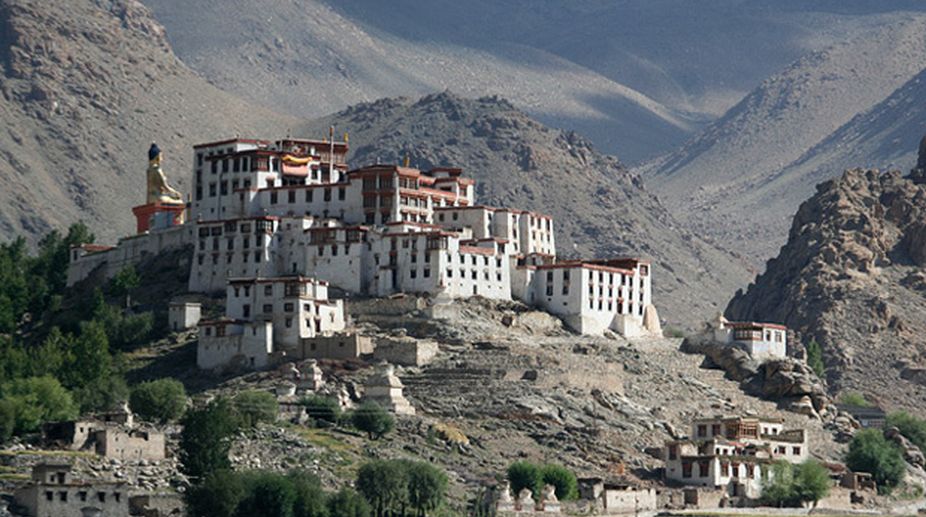Y20 delegates impressed by monasteries, culture of Ladakh
More than 100 delegates from 30 countries arrived in Leh for the formal Y20 meeting to a warm welcome.

Representational Image (Photo: Facebook)
The two major Buddhist monasteries, Hemis and Likir in Ladakh, have refused to remove the “out of bounds” tag for the Archaeological Survey of India (ASI) that has offered to undertake conservation of these tourist attractions. The ASI has for several years been trying to convince monks inhabiting these m monasteries to allow their scientific conservation as they are gradually decaying.
However, the monks have been resisting entry of the ASI in these living monuments that are maintained with offerings of tourists and funds provided by NGOs. Keeping in view the large number of ancient monasteries dotting Ladakh, the ASI has detached the area from the Srinagar circle and created a separate circle for the frontier region.
Advertisement
Tsering Phonchok, in-charge of the circle, confirmed that the ASI was not being allowed to undertake conservation work in the two monasteries. Efforts are being made to persuade the monks to allow expert staff of the ASI to undertake the work instead of engaging inexperienced local masons.
Advertisement
Around 40,000 foreign tourists visit Leh every year and the monasteries are on the top of their itinerary. The pre-eleventh century Hemis monastery is visited by almost every foreign and domestic tourist who comes to Leh. It is situated 45 km from Leh and comes alive in June when the annual Hemis festival to honour Padamasambhava is organised. The Likir Monastery is built on a hillock near the Indus river in Likir village. It belongs to the Gelugpa sect of Tibetan Buddhism and was established in 1065 by Lama Duwang Chosje.
Its verandah has thangka paintings of the Guardians of the four directions and the wheel of life Mandala held by Yama. The courtyard has a large Jupiter tree. Some top Buddhist leaders, who do not want to be identified because of social pressures, said the artistic works in these monasteries are bound to get destroyed because of the inattention of the monks and the government. Monks made a lot of hue and cry when some time ago officials of the ASI went to a monastery to assess the level of damage.
Hundreds of small and big monasteries scattered all over Ladakh region require immediate attention as these might turn into ruins if timely action is not taken. The World Monuments Fund (WMF), New York, has listed Leh in its top 100 most endangered sites in the world. The priceless rich heritage of Ladakh in the form of its monasteries needs sustained preservation and conservation efforts involving both local people and monks in the monasteries, a top tourism expert in Jammu and Kashmir said here today.
Dotted with centuries-old Buddhist monasteries, murals, mud and clay stupas, Ladakh has over 35 Buddhist monasteries which attract a huge number of both domestic and international tourists. Archaeologists and historians in a seminar organised some time ago expressed concern over the decay of the valuable monuments in Ladakh.
They pointed out that the “monasteries are crumbling and need a lot of sincere effort for their preservation but we, at the same time, cannot forget the fact that these monasteries are living temples where Lamas (monks or priests) live and meditate. So, it is every important to involve them in conservation efforts in the monasteries”. The Hemis monastery had suffered major damage in 1992 when restoration was done by the tourism department with the support of monks and local residents.
Monks in several monasteries do not allow authorities to undertake documentation of the heritage in the form of pictures. Reports of managements of some monasteries building new structures instead of preserving the ancient ones have been received. The monasteries have a wealth of artefacts, Lamayuru, the oldest religious centre of Ladakh, beats all others in sheer grandeur. In its uniqueness of wood carving, statues and frescoes, Alchi offers the highest rewards.
The wealth of its possession and its annual summer festival make Hemis the most popular, while Thiksay rates high in terms of architectural impact and the beauty of the festival performances at Likir and Phyang with their proximity to Leh are great attractions while the accessibility of the Shey, Spituk and the Sankar monasteries make them suitable for visitors with time at a premium.
Advertisement
More than 100 delegates from 30 countries arrived in Leh for the formal Y20 meeting to a warm welcome.
On the occasion of Hemis Festival, Sahapedia looks at five cham dances—the Skeleton Dance, the Deer Dance, The Black Hat Dance, The Old White Man from Mongolia, and the Cham Gar—that are performed in various Buddhist monasteries across India, Tibet and Nepal on different occasions.
Tibetan spiritual leader Dalai Lama would celebrate his 83rd birthday in Ladakh in Jammu Kashmir, a spokesperson of Tibetan government-in-exile…
Advertisement
